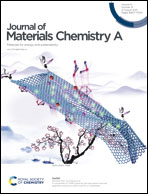Single-atom catalysts of TM–porphyrin for alkali oxygen batteries: reaction mechanism and universal design principle†
Abstract
Single-atom catalysts (SACs) have been intensively explored for many electrochemical reactions, but rarely in nonaqueous alkali oxygen batteries. A picture (activity trend, reaction mechanism and design principle) of SACs for nonaqueous alkali oxygen batteries remains to be built up. Here, using first-principles, we construct such a picture by systematically investigating the catalytic activities of SACs of transition metal–porphyrin (TM–porphyrin) in Li–O2 batteries. Through fully exploring the possible reaction pathways, we reveal the reaction mechanism and chemical compositions of reaction products, and find that Fe/Co/Ni/Cu–porphyrin are promising cathode electrocatalysts for Li–O2 batteries. The influences of various axial ligands on their catalytic performances are also studied. More importantly, based on the catalytic activities of free and axial ligand adsorbed Fe/Co/Ni/Cu–porphyrin, the adsorption free energy of LiO2 is identified as a simple activity descriptor suitable for these cathode electrocatalysts. We further show that such a descriptor is also applicable for the catalytic activities of Fe/Co/Ni/Cu–porphyrin in Na–O2 batteries. Our work not only provides a series of highly efficient SACs for alkali oxygen batteries, but also presents a universal design principle.



 Please wait while we load your content...
Please wait while we load your content...